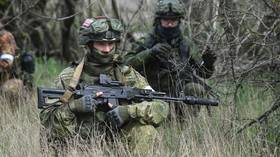BREAKDOWN: Why Ukraine’s much-anticipated ‘counteroffensive’ could end in failure
Are the Armed Forces of Ukraine ready to mount such a high-stakes operation and what challenges will they face?
Talk about a counteroffensive by the Armed Forces of Ukraine (AFU) has been doing the rounds for months, but it is still not clear when it might begin or whether it will happen at all. Previously, RT analyzed the readiness of the AFU for such an operation, but this time we will discuss the main challenges that may prevent Kiev’s troops from implementing or developing its political leaderships aims. And, perhaps most importantly, those of its Western sponsors.
What is the AFU’s main challenge in mounting this sort of endeavor?
We currently do not have any idea of where the AFU’s counteroffensive could take place, although Russian military bosses will be well aware of troop movements. If it involves an attempt to breakthrough the front line, then in addition to preparing reserves for battle, the AFU will need high-precision weapons.
Ukrainian troops will have to use long-range artillery rocket systems, including the US-supplied M142 HIMARS MLRS. Since the start of Moscow’s offensive, Kiev has used these systems only from deep within its own territory. However, to achieve momentum and penetrate the defense line, the systems will have to be moved closer to the front.
The current number of HIMARS rocket launchers (about 35 units) may not be enough for a counteroffensive along the entire front line, which stretches for 1,000km. The systems will probably be concentrated in just one or two directions, but this makes them easier to detect and destroy. Moreover, Ukraine only has a finite supply of missiles for most of its Western weapons systems, like the HIMARS, which means the manner in which they can be used is limited. These systems have never been tested in high-intensity conflicts.
There is currently no doctrine or tested recommendations on using HIMARS/M270 MLRS in combined arms warfare or in such a large-scale war against a technologically advanced enemy.
Difficulties with logistics
Considering the risk of detection in areas with concentrated equipment, and Ukraine’s fear of losing reserves, as we see happening in Artemovsk (Bakhmut), the AFU will likely prepare its most important military formations from 12 to 36 hours before the main strike. In the present conditions, it is nearly impossible to amass enough fuel and ammunition. Not to mention the difficulties in trying to position people secretly. Russia has already used Lancet drones to hit German Gepard anti-aircraft guns and Soviet S-300 missile systems close to the front line. As soon as Ukraine’s previously hidden equipment was moved closer to the front line, it became easier to destroy.
This demonstrates that the routes used for transporting Ukrainian military equipment and the places where it is positioned are under Russian surveillance. If the AFU loses significant amounts of fuel – or transport equipment or engineering units – in the first two or three days, it will have to adjust the counteroffensive’s strategy on the go or implement a backup plan (if it has one). Moreover, Ukraine has no means of transferring reserves by air or conducting amphibious warfare. Its supply and logistics fully depend on roads and railways. In such conditions, the destruction of a bridge or a train line on an important supply route may lead to a disaster at the front.
With so many challenges, is it possible that the AFU could postpone the counteroffensive?
To successfully carry out a major counteroffensive, the AFU may not employ hi-tech equipment (like Bayraktar drones or M142 HIMARS systems) and instead rely on brute force: artillery, tanks, large numbers of infantry, and enormous amounts of cartridges, missiles, and shells. However, if something goes wrong, it will be difficult for Kiev to quickly replenish its ammunition. Ukraine’s troops are almost entirely dependent on foreign military aid, including critical weaponry like mortar shells, 122mm, 152mm, and 155mm artillery munitions, anti-tank systems, and cartridges for small arms. We can be certain that its General Staff understands this and the counteroffensive will take these restrictions into account. It’s also clear that the AFU lacks the power to break through a three to five line defensive front.
What conclusion can we reach?
Judging by the means at the disposal of the AFU, right now, Ukraine is likely to use the units formed with Western help in a rapid attempt to “puncture” the front.
Taking into account the current number of reserves, problems with logistics, and other challenges that will surely surface after the start of the counteroffensive, Kiev’s only realistic option is to launch an attack from a specific and previously unannounced direction.
Possible locations include Kherson, the Lugansk People’s Republic, or Zaporozhye. As a backup option, the AFU may consider attacking villages in the Kursk, Bryansk, and Belgorod regions, which are internationally recognised as part of Russia. However, the main challenge for Ukraine is that its first major strike – or even attempts to accumulate forces – may give the game away, and thus kibosh the whole plan.
You can share this story on social media:










Comments are closed.